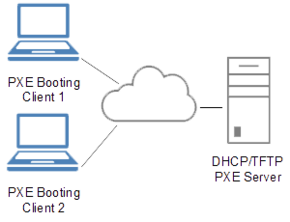This article needs additional citations for verification. (May 2021) |

In computing, the Preboot eXecution Environment, PXE (most often pronounced as /ˈpɪksiː/ pixie, often called PXE Boot/pixie boot.) specification describes a standardized client–server environment that boots a software assembly, retrieved from a network, on PXE-enabled clients. On the client side it requires only a PXE-capable network interface controller (NIC), and uses a small set of industry-standard network protocols such as DHCP and TFTP.
The concept behind the PXE originated in the early days of protocols like BOOTP/DHCP/TFTP, and as of 2015[update] it forms part of the Unified Extensible Firmware Interface (UEFI) standard. In modern data centers, PXE is the most frequent choice[1] for operating system booting, installation and deployment.
- ^ Avramov, Lucien (December 31, 2014). The Policy Driven Data Center with ACI: Architecture, Concepts, and Methodology. Cisco Press. p. 43. ISBN 978-1587144905.
In modern data centers, administrators rarely install new software via removable media such as DVDs. Instead, administrators rely on PXE (Preboot eXecution Environment) booting to image servers.